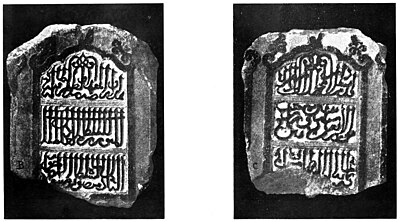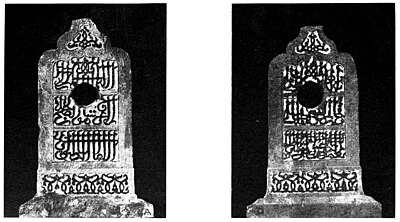Journal of the Straits Branch of the Royal Asiatic Society/Volume 78/The Tomb of Mansur Shah
The Tomb of Mansur Shah, Sultan of Malacca, 1459-? 1475 A. D.
By R. O. Winstedt.
(With two plates)
When I was last in Europe, Mr. Blagden gave me a transcript of the inscription on a tomb purporting to be that of Sultan Mansur Shah, one of the rulers of Malacca before the advent of the Portuguese. Mr. Hervey had got two the inscriptions transcribed and had told Mr. Blagden that the tomb still existed. Mr. Blagden asked me if I could trace, it. On a visit to Malacca, I found the two stones of the tomb placed against the wall of the Residency: Mr. Wolferstan kindly arranged for them to be photographed and undertook to take steps for their preservation. The photographs have been reproduced for its Journal.
An account of Sultan Mansur Shah's reign will be found on pp. 24-26 of Wilkinson's "History, Part I" in the Papers on Malay Subjects" (F. M. S. Govt. Press, Kuala Lumpur).
According to Hervey's version, the inscription of the face at the bottom (or left) of Plate I should be deciphered as follows:—
"Hadze raudzat al-mukaddasat wa'l-daulat al-tamih, al-matharat al-Sultan al-munawar al-adil al-malik al-badzil al-Sultan al-marhum Mansur Shah, kad antakala min dar al-mahal ila dar al-wirad yaum al-arbaa sanat dua Rajab wa thamanin wa thaman mi'ah."
The translation is.
"This is the tomb of the illustrious high and righteous glorious and just Sultan, the beneficent prince, the ruler loved of God, Mansur Shah. He departed this mortal abode for the abode of bliss on Wednesday, the second day of the month of Rejab in the year of the Hegira 880."
The inscription on the two edges of the tomb is deciphered:— which means
"Al-asma' al-dufana' al-Sultan al-Ali."
"The name of the deceased, the most exalted Sultan."
The 2nd of Rějab 880 A.II. = Wednesday, Nov. 1, 1475 A.D. But unfortunately the bottom line of the inscription would seem to have been chipped and damaged since Hervey's day. If the date is correct, the tomb will be the oldest known relic in Malacca, perhaps with the exception of the Hindu makara at the foot of the Residency hill.
It is fair to add that a local Arab pundit to whom photos of the tomb were submitted could not make the above version out of the inscription and failed to give an intelligible interpretation. It would require a scholar acquainted with the carved Arabic script of that period to give a final interpretation: possibly Hervey got his version from such a scholar but there is no record. The hole in the other stone finds a parallel in the hole of the Pengkalan Kempas tomb.


TOMBSTONE OF SULTAN MANSUR.

TOMBSTONE OF SULTAN MANSUR.